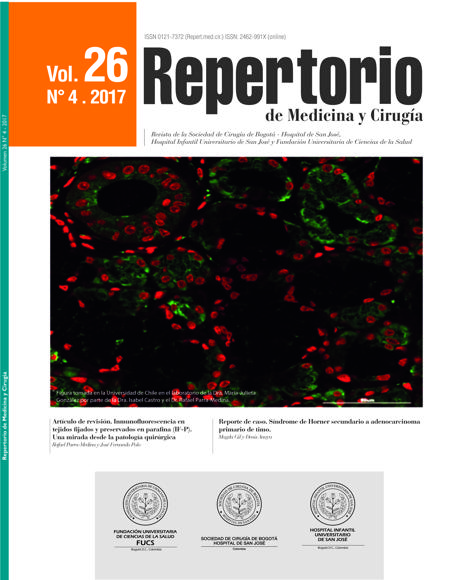Prevalence of malignancy in patients with abnormal nipple discharge assessed at the breast specialist clinic
Prevalencia de malignidad en las secreciones patológicas por pezón evaluadas en consulta de mastología
![]()
![]()

Show authors biography
Objective: To describe the prevalence of malignancy in patients presenting with pathologic nipple discharge (ND) attending the breast specialist clinic of San José and Infantil Universitario de San José hospitals between January 2009 and January 2015.
Materials and methods: A cross-sectional cohort study conducted in patients who consulted for abnormal ND or with ND found in the clinical examination. Men and lactating and pregnant women were excluded.
Results: Seventy (70) patients consulted for abnormal ND, 38.5% had discharge from the right nipple (27 breasts), 32.8% from the left nipple (23 breasts) and 28.5% had bilateral ND (40 breasts), obtaining a total of 90 affected breasts. This complaint was the reason for consultation in 98.6%. Most of the cases were found in the premenopausal women population (47.1%, 33/70). An intraductal papilloma was the cause of ND in 16.6% and the malignancy rate found in these patients was 2.8% (2/70 patients).
Conclusions: A malignant lesion must be ruled out in patients presenting with nipple discharge by performing further imaging investigations to best define medical management.
Article visits 532 | PDF visits 269
Downloads
1. Cebrián C, Ortego J. La telorrea como manifestación del carcinoma intraductal de mama. Prog Obstet Ginecol. 2010;53:476–9.
2. Torregroza-Diazgranados E, Gómez M. Tumores papilares intraductales del seno. Rev Colomb Cir. 2010;25:131–50.
3. Gulay H, Bora S, Kilicturgay S, Hamaloglu E, Goksel HA. Management of nipple discharge. J Am Coll Surg. 1994;178:471–4.
4. Leis HP Jr. Management of nipple discharge. World J Surg. 1989;13:736–42.
5. Jatoi IKM. Nipple discharges. Management of breast diseases. Heidelberg: Springer; 2010. p. 42–55.
6. Hussain AN, Policarpio C, Vincent MT. Evaluating nipple discharge. Obstet Gynecol Surv. 2006;61:278–83.
7. Lorenzon M, Zuiani C, Linda A, Londero V, Girometti R, Bazzocchi M. Magnetic resonance imaging in patients with nipple discharge: should we recommend it? Eur Radiol. 2010;21:899–907.
8. Moriarty AT, Schwartz MR, Laucirica R, Booth CN, Auger M, Thomas NE, et al. Cytology of spontaneous nipple discharge–is it worth it? Performance of nipple discharge preparations in the College of American Pathologists Interlaboratory Comparison Program in Nongynecologic Cytopathology. Arch Pathol Lab Med. 2013;137:1039–42.
9. Sakorafas GH. Nipple discharge: Current diagnostic and therapeutic approaches. Cancer Treat Rev. 2001;27:275–82.
10. Carvalho MJ, Dias M, Gonçalo M, Fernandes G, Rodrigues V, de Oliveira CF. What is the diagnostic value of nipple discharge cytology and galactography in detecting duct pathology? Eur J Gynaecol Oncol. 2009;30:543–6.
11. Seow JH, Metcalf C, Wylie E. Nipple discharge in a screening programme: Imaging findings with pathological correlation. J Med Imaging Radiat Oncol. 2011;55:577–86.








